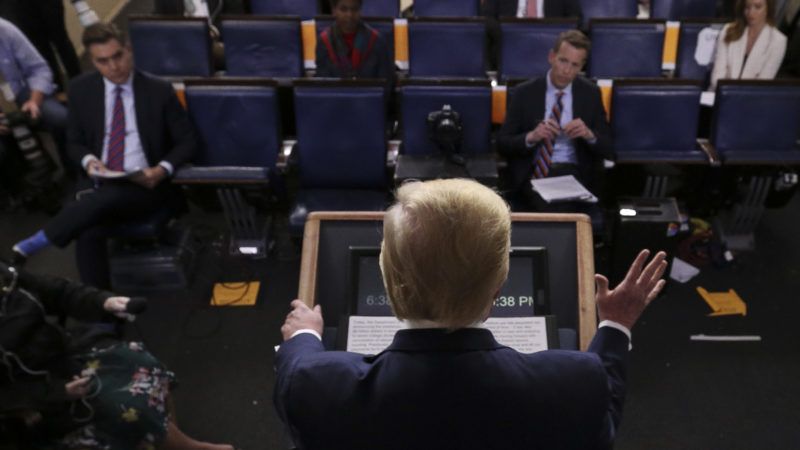Trump's Plan To Reopen the Economy Admits Governors Are in Charge, but We're Probably Months Away From Anything Resembling Normalcy
"A national shutdown is not a sustainable long-term situation," Trump said Thursday evening. "We are not opening all at once, but one careful step at a time."

Just two days after (falsely) claiming that the federal government had "absolute power" to decide when America's COVID-19 economic shutdown would end, President Donald Trump outlined a plan on Thursday that would put state governments in charge.
"A national shutdown is not a sustainable long-term situation," Trump said Thursday evening from the White House. "We are not opening all at once, but one careful step at a time. And some states will be able to open up sooner than others."
That makes sense, of course. As just about everyone from political pundits to constitutional scholars has noted, it was states and local governments that acted to shut down schools and nonessential businesses and that ordered people to stay home to stop COVID-19's spread. Moving in the opposite direction would require state and local governments to lead (and, really, for people to decide to listen). That Trump is seemingly stepping aside is a positive sign.
As for the plan itself, the Trump administration is rolling out a three-stage process that can play out differently in every state—although it's really a four-step process because just getting to phase one requires two weeks of a downward trajectory in new coronavirus cases and evidence that hospitals are not being overwhelmed.
In phase one, the administration says vulnerable individuals should continue to shelter at home, gatherings of 10 or more people will be prohibited, schools would remain closed, and employees would be strongly encouraged to work from home whenever possible. Bars, restaurants, gyms, and other gathering places could be permitted to open, but only if they "adhere to strict physical distancing" guidelines.
Two more weeks of downward trends will allow states to progress into phase two. At that point, gatherings of more than 50 will be prohibited, but schools would reopen and nonessential travel would resume. Bars and restaurants would reopen with restrictions on capacity.
Eventually, states will advance to phase three. That would allow for individuals to visit loved ones in nursing homes once again. Large venues like movie theaters and arenas could open with some restrictions on attendance. During Thursday's press conference, Dr. Anthony Fauci said sporting events with spectators might be able to resume during phase three.
"This is a gradual process," Trump said, with an emphasis on protecting senior citizens and other vulnerable populations. He said all Americans should continue to practice social distancing. He said the White House would encourage states to form regional groups to cooperate on reopening strategies—something that was already happening without federal approval or direction.
It remains unclear whether individual states or groups of states will adopt these federal guidelines, or how strictly they will adhere to them. Rather than a specific plan for reopening the economy, Trump's guidelines seem intended to nudge governors toward partial reopenings in the coming weeks, particularly in places where the coronavirus outbreak is not currently severe.
Another aspect of the plan that remains highly uncertain, however, is how long it might take states to progress from their current situations to phase one and subsequent phases.
In an interview with CNN on Thursday afternoon, Delaware Gov. John Carney, a Democrat, said his state was probably "days, maybe weeks" away from meeting the testing benchmarks necessary to move into the first phase of the Trump administration's three-step plan. Each of the three phases will last at least two weeks—and perhaps longer if there is a resurgence of the virus or if other benchmarks can't be hit.
As a practical matter, then, it's virtually impossible for any state to advance to phase three—the stage at which some semblance of normality would return, even if large-scale gatherings and some sporting events are probably still on hold—until mid-June. And that's assuming there is enough testing available within the next two weeks, and that everything else goes perfectly smoothly, which it almost certainly won't.
There's a famous scene from the sitcom 30 Rock in which Tiny Fey's character's boyfriend, a pilot (Matt Damon!), explains that airline passengers are usually told pre-flight delays will take "about another half-hour" even if the airline and pilot know the delay might be much longer.
"The half-hour thing; it's a trick," he explains to an exasperated Fey. "It's enough time so that people know they are going to have to wait, but it doesn't upset them."
That seems to be the basic idea that the Trump administration and governors have latched onto. With growing unrest about how shutdowns have been handled so far, the plan unveiled Thursday lets people know they are going to have to wait. Whether it upsets them remains to be seen, but at least the appearance of a plan to reopen the economy is probably better than not having a plan at all.

Show Comments (129)